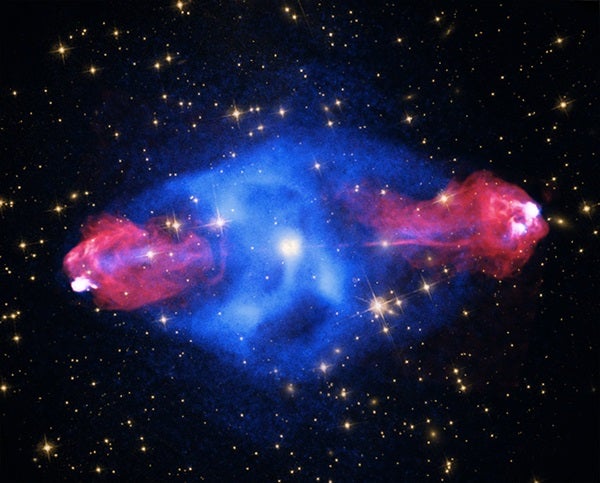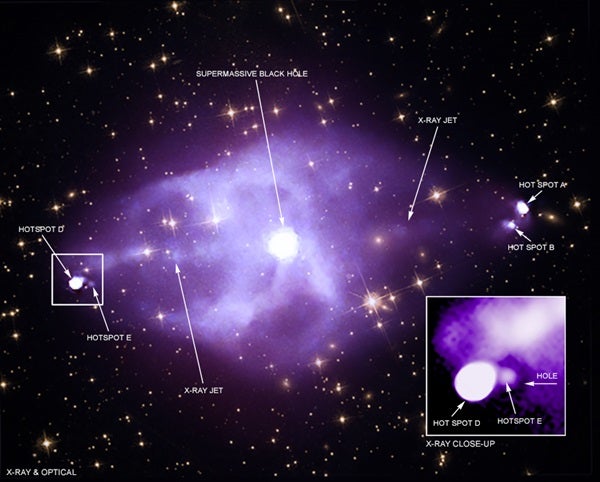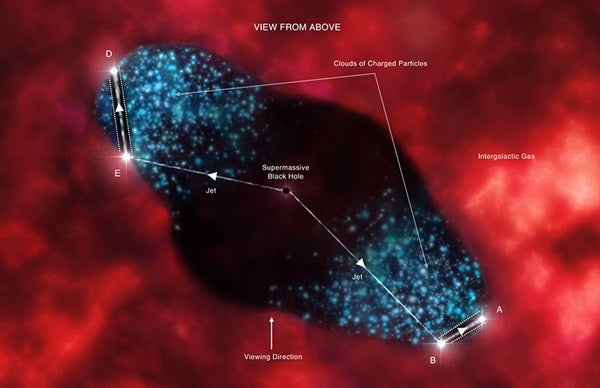Inside a radio galaxy
Cygnus A is a massive elliptical galaxy; it is also one of the most powerful sources of radio emission in the sky. Astronomers believe that as material falls onto the supermassive black hole in Cygnus A’s center, the black hole launches huge, energetic jets that generate radio waves picked up here on Earth. Radio galaxies like Cygnus A are intriguing objects, but most are hard to study because they’re also distant. At 600 million light-years away, “[Cygnus A] is actually exceptionally close for galaxies of its similar luminosity and jet power, which are found at much higher distances,” explained Amalya Johnson of Columbia University during a press conference January 9 at the 233rd meeting of the American Astronomical Society.
“This feature was of interest to us because it has not been seen before in galaxies like Cygnus A or on this scale, and is not seen around any of the other hotspots in Cygnus A,” said Johnson. She and her colleagues compared X-ray emission from the dim area to the regions around it, finding that the dim region is a hole, or cavity, carved out in the galaxy’s gas. That hole is also deeper than it is wide, instead of a simple sphere, as the team had first assumed. Based on their estimates, the hole is between 50,000 and 100,000 light-years deep, but only about 26,000 light-years wide. (For reference, the distance between the Sun and the center of our Milky Way is also about 26,000 light-years, while our galaxy itself is about 100,000 to 150,000 light-years across, from end to end.)
And that discovery revealed even more detail about what’s going on at both hotspot E and D. “This discovery that the hole is deeper than it is wide is what led us to believe that hotspot E is the primary hotspot where the jet is first hitting the surrounding gas,” Johnson said. “Then [the jet] is being deflected in such a way that we are looking down the line of sight of the jet as it is moving away from us.”
Looking at the X-ray image again, it’s worth noting there are also two hotspots on the other side of the galaxy: A and B. “The same process could be occurring on the western side of Cygnus A, but the jet here could be moving at a closer angle to our line of sight, so we see a brightness rather than dimness. It could moving more across our line of sight than straight away from us,” Johnson said.
“Since jets play such a significant role in galaxy formation, a greater understanding of how they work is important in understanding how massive galaxies form and evolve. It also gives us insight into how jets and black holes interact with their surroundings,” Johnson said. By studying the relatively nearby Cygnus A, astronomers can get a glimpse into processes that may be occurring in faraway galaxies that we don’t have the ability to zoom in on in such great detail. It also proves that once again, looks can be deceiving — every astronomical image is a two-dimensional representation of a three-dimensional object, and sometimes those objects can be more complex than they first appear.













